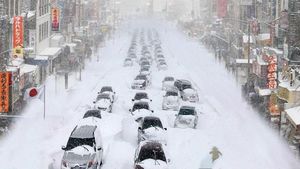Severe winter weather is making its presence felt across North America, leading to disrupted lives and hazardous conditions. Millions of residents, particularly across the southeastern United States and parts of Canada, are bracing for intense snowstorms and extreme cold temperatures, stirring concerns of significant disruptions to travel and daily activities.
According to reports, the winter storms are forming as Arctic air masses sweep down, driven by polar vortex disturbances causing chaos from Texas to Quebec. Major cities like Houston and New Orleans are under threat as this rare weather system promises snowfall and icy conditions not seen for decades, presenting challenges for unprepared communities.
"The northeastern U.S. is facing significant weather disruptions due to incoming snow and ice," said Patrick Duplessis, highlighting risks for travel and power outages as the storms progress. The impacts of these conditions stretch approximately 2,000 km along the Gulf Coast, stretching from Texas through to Florida where significant snowfall is expected.
For many areas, including Louisiana, the forecast suggests potentially record-breaking snow levels. Meteorologist Nicolas Lessard commented, "Some areas may see the most snowfall they've experienced in over 100 years," indicating the rare nature of this weather event for regions accustomed to milder winters.
On the Canadian front, regions such as Quebec are not spared from the cold snap, with temperatures predicted to plunge below -20°C—a marker not reached since February 2023. The extreme chill will grip many locales, particularly with northern cities like Matagami recently recording unprecedented low temperatures of -40°C.
Early indications suggest the winter storm's arrival is primed to affect air travel significantly, with airports such as those located near Houston already closing operations to minimize risks. With forecasts predicting snowfall up to 15 cm or more across various southern cities, disruptions to schools and local businesses are anticipated.
Foreign meteorologist Réjean Ouimet explained the peculiarities of the current winter patterns, noting, "Temperatures could drop to levels not seen since before February 2023." The public has been urged to prepare for possible power outages and health risks associated with the extreme cold, especially for those unaccustomed to such temperatures.
Residents are likely to face continued travel threats as road conditions become increasingly dangerous due to snow accumulation and freezing rain. Many highways, including major arteries such as I-10 along the Gulf Coast, are at risk of temporary closures.
Compounding the hazards, the freezing rain expected could lead to ice accumulation—a significant threat as it may cause tree branches to snap under the weight, leading to power outages affecting potentially millions seeking to heat their homes. "Residents are urged to prepare for possible power outages and travel disruptions," emphasized Kevin Cloutier, providing clarity on what the public can do to remain safe during these stormy periods.
Notably, the historical aspect of this winter weather intrusion is remarkable. Since records existed, New Orleans has only seen measurable snowfall eight times since 1948—an indication of the rarity of such events. For some, this storm can potentially rank as the largest winter storm to impact the region since 130 years.
Though the calendar indicates we are nearing the transition to spring, the extreme winter conditions are stark reminders of how volatile weather patterns remain. While many hope to see the warmth return soon, the existing instability holds the potential for more unusual weather occurrences as these systems pass through.
Continuing through February, communities are left to navigate these severe weather challenges, equipped with the knowledge of historical data and cautious optimism from experts urging preparations for future cold snaps.
Consequently, as severe weather rages, the anticipation of potential long-term impacts on infrastructure, energy supplies, and public safety remains high. With ever-changing conditions, it is increasingly clear: winter is far from over, and communities must be prepared to face what might come.



